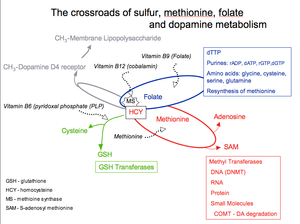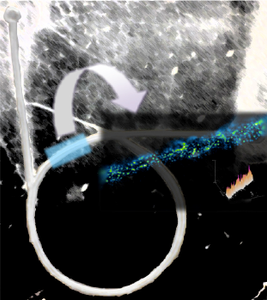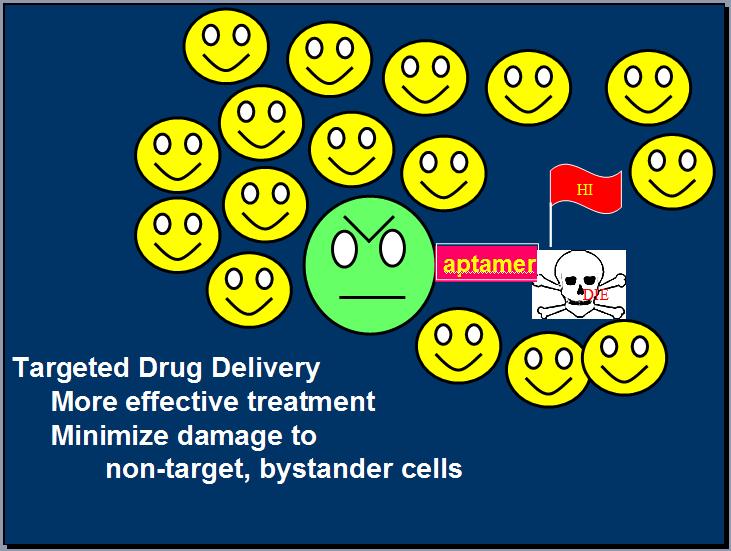
SchizoGAD
In a departure from previous work, my current research focuses on complex diseases. One area is genomic stability and disease, especially Schizophrenia, in twins. Now, we have our first major paper in this area in press. A second area is on the development of DNA mimics of antibodies, aka aptamers, against tumor cells. Here, an anti-carcinoembryonic antigen (CEA) aptamer was selected (manuscript in preparation) and is now being tested in vitro. These areas of research might seem disparate, but they both involve new technology development.
Genomic Stability: This work began as a new and simple approach for finding genes important in complex diseases like Schizophrenia. The focus was on monozygotic (MZ) twins discordant for Schizophrenia. The assumption is that the identical genomes of MZ are modified over time, and some changes cause, or influence, disease occurrence. The use of twins for disease studies means only pair-wise comparisons need be done in contrast to positional cloning approaches that typically required genetic mapping experiments in large families.
First we developed an efficient method, targeted genomic differential display (TGDD), to compare DNA from twins or other closely matched samples (e. g. or clones or different tissue from the same individual) at a variety of sequences. TGDD compare the composition of pools containing selected genomic restriction fragments having a target. The target sequences range from simple repeated sequences (e. g. (AT)n) to more complex sequences that encode protein motifs. Targeting serves two purposes. It focuses the analysis to a pre-selected class of fragments that contain a target sequence. In large genomes, like the human genome, targeting reduces the complexity of the restriction fragment pool to enable analysis.
In TGDD, genomic DNA is cleaved with a restriction enzyme and ligated to synthetic oligonucleotides (called adapters). PCR using primers complementary to the target and the adapter sequences amplifies the selective class of genomic fragments. In some experiments, genomic DNA is hybridized to an immobilized single-stranded DNA complementary to the target sequence before PCR to enrich for the selected fragments. Complex, high-resolution DNA fingerprints of fragment pools are generated by electrophoretic size fractionations on an automated DNA sequencing instrument. The size distribution patterns are compared by automated methods developed by us that deconvoluted high-resolution Gausian-like peaks to impulses and scores differences between paired samples. This data processing allows the number of differences between samples to be determined rapidly. Specific differences are isolated and further studied. Ongoing experiments are adapting these experiments to DNA arrays.
 TGDD was used to compare MZ twin-pairs affected by Schizophrenia. The study included 12 pairs of twin-pairs presented to us as MZ: 4 were concordant and 4 discordant for Schizophrenia, and 4 unaffected by disease. The number of anonymous fragments in pools targeted to contain (CAG)n repeat sequences was determined for each twin-pairs discordant for Schizophrenia overlapped the level seen in sib-pairs. In contrast, the level of differences in twin-pairs concordant for, or unaffected by, Schizophrenia was greater than that of sib-pairs.
TGDD was used to compare MZ twin-pairs affected by Schizophrenia. The study included 12 pairs of twin-pairs presented to us as MZ: 4 were concordant and 4 discordant for Schizophrenia, and 4 unaffected by disease. The number of anonymous fragments in pools targeted to contain (CAG)n repeat sequences was determined for each twin-pairs discordant for Schizophrenia overlapped the level seen in sib-pairs. In contrast, the level of differences in twin-pairs concordant for, or unaffected by, Schizophrenia was greater than that of sib-pairs.
These results can be explained by postulating that the genomes of twins discordantly afflicted with Schizophrenia have an increased susceptibility to changes around (CAG)n repeat sequences after the twinning event. Twins concordant for Schizophrenia, do not have a similar susceptibility after the twinning event, but may have passed through period with a high mutation rate before the twinning event, perhaps even in previous generations. In these studies we could not rule out the possibility that some twin-pairs discordant for Schizophrenia are dizygotic, not MZ, twins. An evaluation of the manner and assumptions used in zygosity testing for the twin-pairs examined in this study, and other studies, is flawed and is being reinvestigated.
We uncovered other evidence that supports the idea that the genomes of Schizophrenia victims are unstable. A meta analysis of published data detected an excess co-localization of (a) cytogenetic abnormalities found in individuals with Schizophrenia and (b) candidate regions and genes revealed through genetic mapping experiments in families segregating Schizophrenia to fragile site locations (X2:P = 0.01). Fragile sites are regions of the genome that are known to be unstable, are believed to be composed of simple repeating sequence, and an increasing number of neurodegenerative disease genes are mapping to specific fragile sites. There are 122 fragile sites distributed throughout the genome, although the sequence composition of only 10 sites is known. Hence, two disparate phenomena suggest that Schizophrenia is associated with mutations at multiple fragile sites. Cancer is the only other disease that is associated with multiple fragile sites, and genomic instability is a characteristic of cancer cells.
 The hypothesis that Schizophrenia is due to genomic instability, especially at fragile sites is supported by other observations on the occurrence of the disease. This includes environmental factors that may affect DNA structure including the occurrence of famine, infection, hypoxia such as might occur during birth complications, and the age of fathers (but not mothers).
The hypothesis that Schizophrenia is due to genomic instability, especially at fragile sites is supported by other observations on the occurrence of the disease. This includes environmental factors that may affect DNA structure including the occurrence of famine, infection, hypoxia such as might occur during birth complications, and the age of fathers (but not mothers).
Fathers solely contribute DNA to progeny. Further, germ line DNA in sperm from fathers undergoes significantly more rounds of replication than germ line DNA in eggs from mothers. Hence, there is a continuing and cumulative potential for environmental factors to interfere with DNA replication in fathers. Environmental factors that interfere with DNA replication or repair have potential to especially perturb the structure of simple repeating sequences. The spectrum of symptoms associated with Schizophrenia even within the same family might represent the number of changes that have occurred in both the heritable found in germ line cells and the disposable genome found in somatic cells.
The association of Schizophrenia with genomic instability hints at ways of preventing and/or minimizing the symptoms of this disease. Current studies are isolating DNA libraries to determine what mutations have occurred in twin-pairs discordant for Schizophrenia. Further, we are beginning to explore an animal model of paternal age and malnutrition and genomic instability. The goal of these experiments is to determine what spectrum of sequences are unstable, what causes the instability and how to prevent changes to the genome early in development.
Anti-tumor aptamers: Our long-term goal is to develop methods for targeting tumor cells in vivo. Thus far, antibody targeting of tumors has not proven effective. Large antibodies get stuck in the kidneys, and in most cases, highly specific tumor epitopes have not been identified. Our work uses DNA aptamers (meaning in Latin “to fit”) for tumor targeting. Aptamers are small, single-stranded oligonucleotide or peptide mimics of large antibodies. These short polymers (e. g. ~20-100 mers) fold into stable three-dimensional structures that have highly specific and selective binding activities.

Goal: A queried molecule differentiates between healthy and cancerous cells
Aptamers are selected from large libraries of random sequence by their affinity to a chosen target. Although aptamers have been selected against small targets, conventional selection protocols are not effective with large targets and few, if any aptamers have been isolated for glycosylated proteins. We developed methods that allow us to select aptamers against carcinogenic embryonic antigen (CEA). This first target was chosen because of the wealth of prior research on CEA. Only recently we learned that a number of expert groups were unsuccessful in their attempts to isolated anti-CEA aptamers. Currently, we are analyzing a library of anti-CEA aptamers that appear to have submicromolar Kds. The goal is to identify the aptamer with the best binding affinities for CEA and tumor cells in vitro. The best aptamers will be tested for their ability to transverse a endothelial cell layer to access tumor cells in a complex in vitro model, and ultimately will be tested in a human tumor xenograph model in immuno-compromised mice.
Other experiments are exploring the use of multivalent aptamers. Nature uses multivalency in antibody design to produce antibodies where multiple weak binding sites are combined to created high affinity antibodies. In multivalent systems, the dissociation of one binding site from a target is quickly reversed because an undissociated second binding site continues to holds the aptamer and target together. In these experiments, small DNA structures consisting of suitable single-stranded and double-stranded region that hold two or more aptamers together at various distances and with variable flexibility. Thus far, we have demonstrated the enhanced binding of multivalent DNAs in model systems. Future studies will test multivalent anti-CEA aptamers designs and use appropriate multivalent designs to select additional anti-tumor aptamers. For instance, selection of additional aptamers will be done using a test library will consist of molecules with an anti-CEA arm and a random sequence arm. Here, the target search space of the random sequence arm is limited to the tumor cell surface through the anti-CEA aptamer – CEA linkage.
